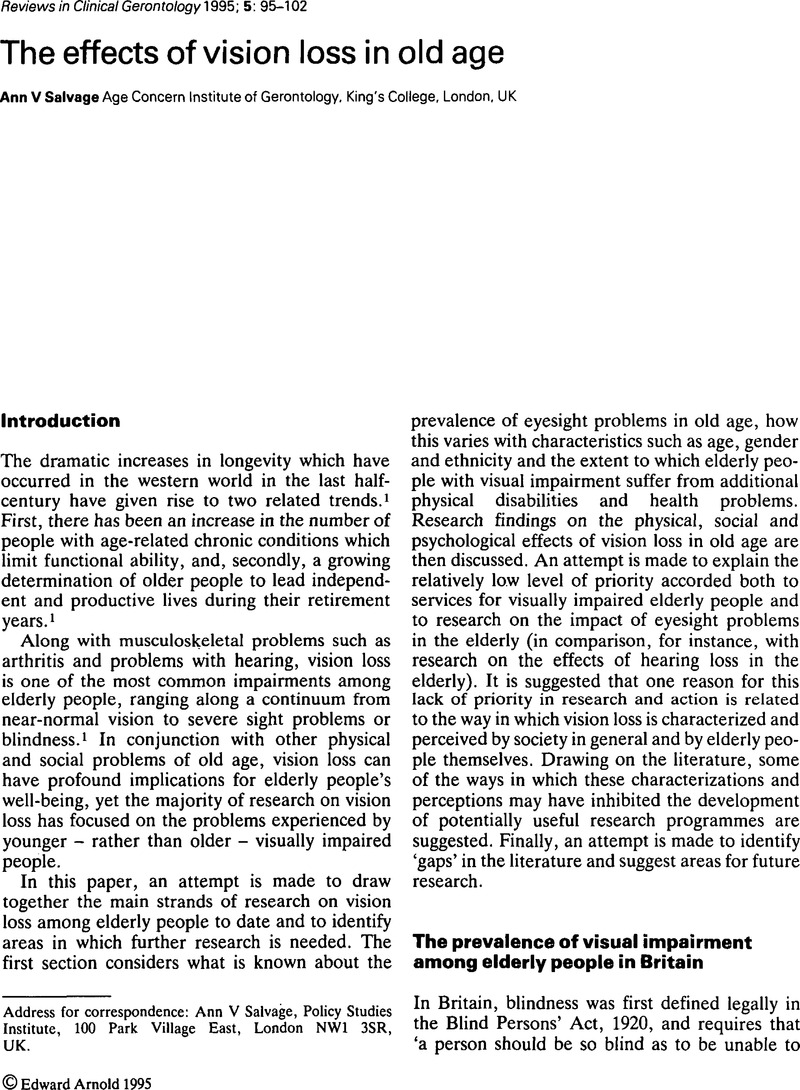No CrossRef data available.
Article contents
The effects of vision loss in old age
Published online by Cambridge University Press: 17 November 2008
Abstract
An abstract is not available for this content so a preview has been provided. Please use the Get access link above for information on how to access this content.

- Type
- Social and psychological gerontology
- Information
- Copyright
- Copyright © Cambridge University Press 1995
References
1 Levy, SB, Gordon, AR. Age-related vision loss: functional implications and assistive technologies. Int J Technol Ageing 1988; 1(2): 116–25.Google Scholar
3 Department of Health. Registered blind and partially sighted people at 31 March 1991: England. Personal Social Services Local Authority statistics, prepared by the Government Statistical Service, 1991.Google Scholar
6 Shaw, DE, Gibson, JM, Rosenthal, AR. A year in a general ophthalmic outpatient department in England. Arch Ophthalmol 1986; 104: 1843–46.Google Scholar
7 Hitchings, R. Visual disability and the elderly. Br Med J 1989; 298: 1126–27.CrossRefGoogle ScholarPubMed
8 Harris, A, Cox, E, Christopher, R. Handicapped and impaired in Great Britain. London: Office of Population Censuses and Surveys, 1971.Google Scholar
9 Martin, J, Meltzer, H, Elliot, D. The Prevalence of disability among adults, Report 1. OPCS Surveys of Disability in Britain; Office of Population Censuses and Surveys, Social Survey Division. London: HMSO, 1988.Google Scholar
11 Page, J. Technological prosthetics for the partially sighted. Laxenburg: Austria: International Institute for Applied Systems Analysis, 1974.Google Scholar
12 Bruce, I, McKennell, A, Walker, E. Blind and partially sighted adults in Britain: the RNIB survey. London: HMSO, 1991.Google Scholar
13 Biegel, DE, Petchers, MK, Snyder, A, Beisgen, B. Unmet needs and barriers to service delivery for the blind and visually impaired elderly. Gerontologist 1989; 29(1): 86–91.Google Scholar
14 Jacobs, PL. The older visually impaired person: a vital link in the family and the community. J Vis Impair Blind 1984; 78(4): 154–62.Google Scholar
16 Stevenson, O. Elderly people and visual impairment: some issues for social service provision. Br J Vis Impair 1985; 3(3): 71–74.Google Scholar
18 Cullinan, T. The epidemiology of visual disability: studies of visual disability in the community. Report no. 28, Health Services Research Unit, University of Kent, 1977.Google Scholar
19 Shore, P. Local authority social rehabilitation services to visually handicapped people, London: Royal National Institute for the Blind, 1985.Google Scholar
20 Wineberg, RJ. The elderly blind: the unseen. J Gerontol Social Work 1981; 4(2): 55–63.CrossRefGoogle Scholar
21 Ringgold, NP. Out of the corner of my eye: living with vision loss in later life. New York: American Foundation for the Blind, 1991.Google Scholar
22 Ross, JE, Bron, AJ, Clarke, DD. Contrast sensitivity and visual disability in chronic simple glaucoma. Br J Ophthalmol 1984; 68: 821–27.CrossRefGoogle ScholarPubMed
23 Ainlay, SC. Day brought back my night: ageing & new vision loss. London: Routledge, 1989.Google Scholar
25 Stafford, M, Scott, R. Stigma, deviance and social control. In: Ainlay, S, Becker, G, Coleman, L eds. The dilemma of difference. New York: Plenum, 1986.Google Scholar
26 Hill, R, Horan, T, Jobbins, M, Jones, V, Mackenzie, S, Tomlinson, D. A wider vision: the management and organisation of services for people who are blind or visually handicapped. DHSS, Social Services Inspectorate, 1988.Google Scholar
27 Negrin, S. Psychosocial aspects of aging and visual impairment. In: Jose, RT ed. Understanding low vision, Chapter 3. New York: American Foundation for the Blind, 1983.Google Scholar
29 Fitzgerald, R. Visual phenomenology in recently blind adults. Am J Psychiatry 1971; 127(1): 533–39.Google Scholar
31 Burack-Weiss, A. In their own words: elders' reactions in vision loss. J Gerontol Social Work 1991; 17(3–4): 15–23.Google Scholar
32 Jones, DA, Vetter, NJ, Victor, CV. Visual disability and associated factors in the elderly. Health Visitor 1987; 60: 256–57.Google Scholar
33 Gillman, AE, Simmel, A, Simon, EP. Visual handicap in the aged: self-reported visual disability and the quality of life of residents of public housing for the elderly. J Vis Impair Blind 1986; 80(2): 588–90.Google Scholar
34 Yeadon, A. The informal care group: problem or potential? J Vis Impair Blind 1984; 78(4): 149–54.Google Scholar


